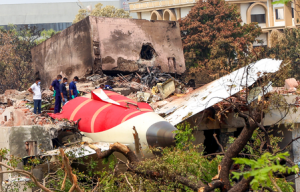AAIB probe report puts focus on fuel switches, pilots action in Air India crash

New Delhi/ Mumbai: The preliminary probe report on the fatal Air India aircraft crash has turned the spotlight on the action of pilots, while the absence of any recommendation for Boeing 787-8 operators seems to have left several questions unanswered as the investigation progresses, experts said Saturday.
Switches that feed fuel into the aircraft’s engines being cut off within a gap of one second, subsequent loss of thrust and altitude before crashing into a building in Ahmedabad are among the major takeaways in the 15-page preliminary report on the Air India plane crash June 12 that killed 260 people.
While the 15-page preliminary report details the sequence of events before the crash that happened in less than a minute after the aircraft took off, certain key elements, such as the whole transcript of the cockpit voice recording and which pilot asked about the fuel switch being cut off after the takeoff, are not there, experts pointed out.
While the exact reasons that led to the accident will be known only in the final investigation report, experts told PTI that the aircraft might have suffered mechanical or power supply issues that could have led to the change in the position of the switches that feed fuel into the plane.
In the preliminary report, the Aircraft Accident Investigation Bureau (AAIB) said the fuel switches of the two engines were cut off immediately, with a time gap of one second after take-off.
“In the cockpit voice recording, one of the pilots is heard asking the other why he had cut off. The other pilot responded that he did not do so,” it said, but there were no specific details about which pilot said what,” said a seasoned widebody Boeing pilot.
“See, they have picked up a few specific words from the CVR. They didn’t release the complete transcript of the CVR. You can’t pick a word out of it and you don’t know the context where he spoke in what the actual word meant. So they are leaving the whole space of speculation for one year as the actual report may take up to one year or more. They are leaving it for one year hanging on this small word (by) keeping it open. They are not blaming, they are not saying they did not do it, ” the pilot said.
The Pilot-In-Command (PIC) of the ill-fated AI171 Ahmedabad-London Gatwick flight was 56-year-old Captain Sumeet Sabharwal and the First Officer was 32-year-old Clive Kundar. Sabharwal’s flying experience with 787 was more than 8,596 hours, including 8,260 hours as PIC, while Kundar’s flying experience with this type of aircraft was 1,128 hours.
Kundar was the pilot flying while Sabharwal was the pilot monitoring for the AI 171 flight operated with the nearly 12-year-old Boeing 787-8 aircraft.
“Both pilots were based at Mumbai and had arrived at Ahmedabad on the previous day. They had an adequate rest period prior to operating the said flight. The co-pilot was Pilot Flying (PF), and the PIC was Pilot Monitoring (PM) for the flight,” the report said.
According to the Boeing pilot, the investigators have left two pieces open– one is the airworthiness directive (AD) on the fuel control switches, where that they said the company is not liable to do, so the Air India didn’t do and this is one thing they left open in it, and other thing is the pilot doing it, so these two things mostly people will take it their way, he said.
“So it comes on the pilot, and they left it open ended, everybody to think on their own but until the whole situation when it is spoken, what is spoken before that, what is spoken after that is known, you can’t judge everything. So you have to ask for the CVR, they must have already got that, when they picked this word, they must have got the CVR transcripts completely they could have released, at least the context from the take of at least 10 minutes, then the people would have correct understanding”, the pilot said.
Airline Pilots’ Association of India disagreed with the report, saying the investigation is “shrouded in secrecy,” appears to be biased against the pilot and has come to a conclusion hastily. It demanded a fair and fact-based probe into the Air India plane crash as it claimed that the tone and direction of the investigation into the Air India plane crash suggests a bias towards pilot error.
The Airline Pilots’ Association of India (ALPA India) is a member associate of the International Federation of Airline Pilots’ Associations (IFALPA).
In Visakhapatnam, Civil Aviation Minister K Rammohan Naidu said one should not jump to any conclusions on the role of pilots in the Air India plane crash, and there are multiple things that need to be looked into before preparing the final investigation report.
A former Director General of Civil Aviation official said there was a change in the position of the fuel switches, and the question is why it happened.
“Now, the investigation will lead in this direction to why this switch position changed, whether it was a mechanical failure, whether it was intentional or unintentional or anything else or if there was a problem… The question is also whether there was a software glitch and or not,” he said.
The Ahmedabad crash was the first time that Boeing’s best-selling Dreamliner suffered a fatal accident resulting in hull loss.
However, AAIB’s report said at this stage of the investigation, “there are no recommended actions to B787-8 and/or GE GEnx-1B engine operators and manufacturers”.
The plane that crashed was powered by GEnx-1B engines.
Among other aspects, the report said fuel samples taken from the bowsers and tanks used to refuel the aircraft were tested at the DGCA’s Lab and found satisfactory.
PTI
News